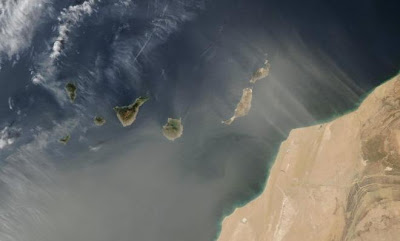Thursday, March 18, 2010
Queensland, Australia Now Expecting a Landfall from Cyclone Ului
0 comments Posted by david at 5:38 PMOn Thursday, March 18 at 1500 UTC (11 a.m. EDT), Tropical Cyclone Ului had maximum sustained winds near 92 mph (80 knots). The storm is about 300 miles in diameter. Tropical storm force winds extend about 155 miles from Ului's center, while hurricane force winds extend 45 miles out from the center. Ului was located about 670 nautical miles east of Cairns, Australia near near 15.9 South and 157.4 East. It has been crawling at 3 mph (2 knots) in a southwestward direction.
Wednesday, March 17, 2010
Tropical Cyclone Ului's cold thunderstorm cloud tops using infrared imagery on March 17 at 10:35 a.m. EDT after the storm had departed the Solomon Islands..
The Atmospheric Infrared Sounder (AIRS) instrument on NASA's Aqua satellite captured Tropical Cyclone Ului's cold thunderstorm cloud tops on March 17 at 10:35 a.m. EDT (14:35 UTC) after the storm had departed the Solomon Islands. The infrared imagery revealed that the two strongest areas where convection was strongest in Ului were in the northern and southern areas around the eye.
It is in those two areas that the highest, coldest thunderstorm tops were revealed by AIRS infrared imagery. Those thunderstorm cloud tops were as cold as -63 Fahrenheit, and were areas where heavy rain was falling.
Monday, March 15, 2010

Powerful Cyclone Tomas Battering Northern Fiji Islands Tomas grew into a monster Category 4 cyclone and thrashed the northern Fiji Islands with heavy rains and maximum sustained winds of up to 170 mph (275 km). The Moderate Resolution Imaging Spectroradiometer instrument on NASA's Aqua satellite captured a visible image of most of Cyclone Tomas on Mar. 14 10:21 p.m. ET and noticed the storm's eye is cloud-filled.
Friday, March 12, 2010

South Atlantic Tropical Storm 90Q Far from Argentina's Coast
The second–ever known tropical cyclone in the South Atlantic Ocean can't escape satellite eyes, and today, the Geostationary Operational Environmental Satellite, GOES-12 captured a visible image of Tropical Storm 90Q now located off the coast of Argentina.
GOES-12 satellite captured an image of Tropical Storm 90Q at 1745 UTC (12:45 p.m. ET) today, March 12, when it was more than 1,350 miles east of Buenos Aires, Argentina, approximately near 36.5 degrees South latitude and 34.8 degrees West longitude. At 10 a.m. ET today, Tropical Storm 90Q still had maximum sustained winds near 46 mph (40 knots).
Wednesday, March 10, 2010
 The Geostationary Operational Environmental Satellite, GOES-12 captured a visible image of System 90Q at 14:45 UTC (9:45 a.m. ET) on March 11, and it appeared as a small circular area of clouds off the Brazilian coast. GOES is operated by the National Oceanic and Atmospheric Administration, and NASA’s GOES Project, located at NASA’s Goddard Space Flight Center, Greenbelt, Md. creates some of the GOES satellite images.
The Geostationary Operational Environmental Satellite, GOES-12 captured a visible image of System 90Q at 14:45 UTC (9:45 a.m. ET) on March 11, and it appeared as a small circular area of clouds off the Brazilian coast. GOES is operated by the National Oceanic and Atmospheric Administration, and NASA’s GOES Project, located at NASA’s Goddard Space Flight Center, Greenbelt, Md. creates some of the GOES satellite images.Tuesday, March 09, 2010

Tropical Cyclone Formation Likely Near Madagascar








